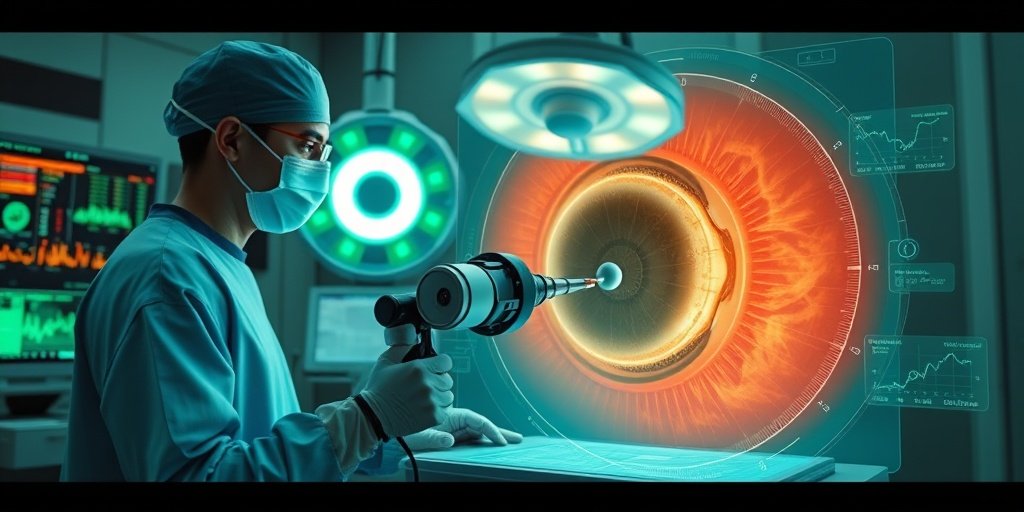⚡ Quick Summary
This study introduces a groundbreaking teleoperated robotic system designed for remote intraocular microsurgery, demonstrating nearly double the first-attempt success rate and significantly fewer complications compared to traditional manual surgery. The system’s precision and reliability could greatly enhance access to specialized surgical care.
🔍 Key Details
- 📊 Study Population: 51 pigmented rabbits
- ⚙️ Technology: Teleoperated robotic system with micrometer-scale precision
- 🏆 Success Rate: Nearly double the first-attempt success rate compared to manual surgery
- 🧪 Procedures: In vivo subretinal injections and removal of microscale intraocular foreign bodies
- 🌐 Communication: Validated stability in multicenter remote surgeries
🔑 Key Takeaways
- 🤖 Robotic telesurgery aims to address healthcare disparities by enhancing surgical precision.
- 💡 The system achieved significantly fewer surgical complications than manual techniques.
- 🌍 Remote surgeries were successfully conducted across the Qiongzhou Strait.
- 🔬 The study validates the system’s safety and reliability for intraocular procedures.
- 🏥 Potential for broader access to specialized care in underserved regions.
- 📈 Versatility demonstrated in various surgical applications, including foreign body removal.

📚 Background
Microsurgery has transformed surgical practices, offering enhanced precision and improved patient outcomes. However, the field faces challenges due to the limited availability of skilled surgeons and the operational difficulties associated with traditional techniques. The advent of robotic telesurgery presents a promising solution to these challenges, aiming to bridge the gap in healthcare access and improve surgical efficacy.
🗒️ Study
Conducted as a randomized multicenter study, this research involved 51 pigmented rabbits to assess the feasibility and safety of the newly developed teleoperated robotic system. The study focused on performing in vivo subretinal injections, a critical procedure in ocular microsurgery, to evaluate the system’s performance against traditional manual methods.
📈 Results
The results were promising, with surgeons utilizing the teleoperated system achieving nearly twice the first-attempt success rate and experiencing significantly fewer complications compared to manual surgery. Additionally, the system demonstrated its versatility by successfully removing microscale intraocular foreign bodies in 15 porcine eyes, further validating its operational capabilities.
🌍 Impact and Implications
The implications of this study are profound. By showcasing the safety, reliability, and versatility of the teleoperated robotic system, it opens the door for remote microsurgery to become a viable option for improving surgical outcomes. This technology could significantly enhance access to specialized care, particularly in regions where skilled surgeons are scarce, ultimately leading to better patient care and outcomes.
🔮 Conclusion
This study highlights the transformative potential of robotic telesurgery in the field of microsurgery. With its ability to improve precision and reduce complications, the teleoperated robotic system represents a significant advancement in surgical technology. As we look to the future, continued research and development in this area could further enhance surgical practices and broaden access to essential healthcare services.
💬 Your comments
What are your thoughts on the advancements in robotic telesurgery? We would love to hear your insights! 💬 Join the conversation in the comments below or connect with us on social media:
Development of Teleoperated Robotic System for Remote Intraocular Microsurgery.
Abstract
Microsurgery has revolutionized modern surgery through its precision and favorable outcomes, but it remains limited by operational difficulty and the scarcity of skilled surgeons. Advances in robotics and communication technology have enabled the development of robotic telesurgery, with the goal of eliminating healthcare disparities. However, insufficiencies regarding system precision, surgical image transmission quality, and operational latency have made remote microsurgery challenging, particularly in intraocular microsurgery. A teleoperated robotic system is presented, featuring micrometer-scale precision and remote center of motion design, to ensure safety and flexibility within the confined operating space of the vitreous cavity. To validate its feasibility and safety, a randomized multicenter study is conducted involving in vivo subretinal injections in 51 pigmented rabbits. Surgeons using teleoperated system achieve nearly twice the first-attempt success rate and significantly fewer surgical complications than manual surgery. Furthermore, the system’s versatility is showcased by successfully removing microscale intraocular foreign bodies in 15 porcine eyes and the communication stability is validated in multicenter remote surgeries, including procedures across the Qiongzhou Strait. These findings establish the system’s safety, reliability, and versatility for performing remote intraocular procedures, highlighting its potential of remote microsurgery to improve surgical outcomes and broaden access to specialized care.
Author: [‘Xu A’, ‘Lian Z’, ‘Chen W’, ‘Li Y’, ‘Liu J’, ‘Liang H’, ‘Song R’, ‘Lin Z’, ‘Li M’, ‘Huang Y’, ‘Jin L’, ‘Zhang Z’, ‘Wei X’, ‘Liu B’, ‘Ma W’, ‘Li T’, ‘Shao H’, ‘Liu W’, ‘Gao K’, ‘Zhang X’, ‘Yan P’, ‘Li R’, ‘Wang R’, ‘Wu X’, ‘Lin D’, ‘Chen X’, ‘Wang J’, ‘Zhong X’, ‘Nasseri MA’, ‘Huang K’, ‘Lin H’]
Journal: Adv Sci (Weinh)
Citation: Xu A, et al. Development of Teleoperated Robotic System for Remote Intraocular Microsurgery. Development of Teleoperated Robotic System for Remote Intraocular Microsurgery. 2025; (unknown volume):e09849. doi: 10.1002/advs.202509849